#modern craft term
Text
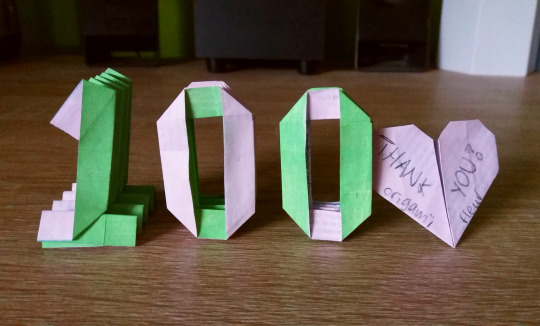
Today I hit 100 followers!!
I just wanted to thank you all for being here! I truly expected nothing from this blog but then I got to talk with really kind and amazing people!
So, thank you all for being awesome and grab a piece of paper. Let's keep on folding! ♥
Number 0 instructions.
Number 1 instructions.
Heart instructions.
#Origami#Papiroflexia#Paper crafts#I know that in terms of modern socmed 100 followers is basically nothing#but who cares? 100 people are enough to fill a big ass room#and you tell me all that people are willing to follow this little blog? of course I'll be thankful!#also yeah my handwriting is ugly but I think it has personality... (? lol
13 notes
·
View notes
Text
As a weird awkward nerd, who is "off-kilter" with interests that are "obscure", learning about pop culture is like learning a new language.
#New terms#new people#new crafts#i like crochet#and latin#not fucking christian bale#movies#books#the “” sections are from my step-mother and baba#family members and relatives#pop culture#learning#modern#gen z#mine specifically for future reference
1 note
·
View note
Text
Arthur’s love language is gift giving, always has been. He realises this when he returns to a modern Albion full of all these new terms and words and definitions. Back before he died, he didn’t have the time to properly make things for his loved ones as he was the King and he was incredibly serious about his duties.
Yet when he returns to a modern world, he finds himself crown-less and with a lot of spare time. Cue discovering YouTube and google, how-to-tutorials, craft books and step by step guides.
Back in Camelot, Merlin was a nightmare to get things for, nothing flashy or expensive or Arthur would have his ear nagged off about wasting money. But now? Paper and paint seem to be limitless to Arthur and he’s just learnt what origami is.
Merlin comes across him one morning to find the returned king fast asleep and surrounded by hundreds of painted paper dragons. It’s the best gift the immortal has ever received.
#immortal merlin#arthur returns#merlin#bbc merlin#arthur pendragon#merthur#headcanon#love language#gift giving
709 notes
·
View notes
Text
Alessandro Volta's Electric Eels
Okay so, it turns out that your cell phone battery is a basically a homunculus of an electric fish.


These are the same thing. Let me explain.
@fishteriously, a paleoichthyologist, told me that Alessandro Volta invented the electric battery after studying electric eels and rays. This sounded like a fun science factoid! I wanted to know more! I saw the claim repeated on any number of pop science articles from the last century or so, but none that quoted from primary sources.
The voltaic pile is one of the most important inventions, ever, of all time. Before Volta, electricity could be stored in Leyden jar capacitors, which would discharge in a single, brief burst. Volta's pile was the first method of producing a continuous electric current, which launched the modern era of electricity as we know it. His explanation for how it worked was incorrect, but it was still a massive breakthrough.
Batteries use the same principle to this day, just with different materials (e.g. cobalt oxide, graphite, and lithium salts rather than silver, zinc, and brine).
But is it a fish?
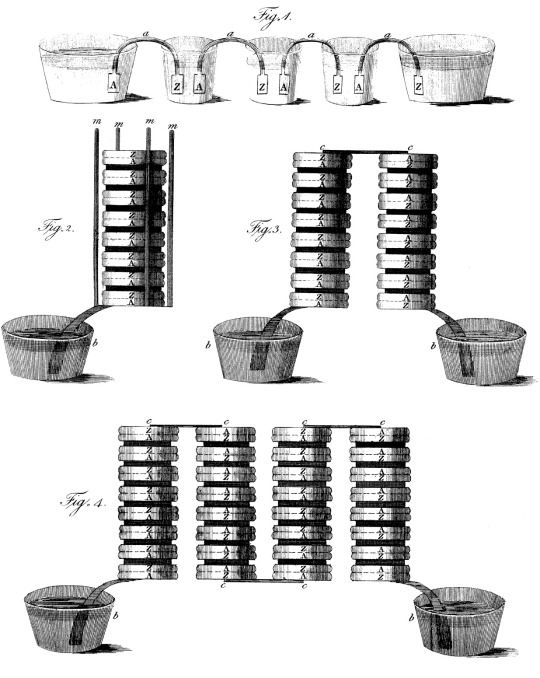
This is Volta's first schematic of a battery, or "voltaic pile" – at the time, "battery" referred to a bunch of Leyden jars linked in series, the term wouldn't come to refer to piles until later. "Z" and "A" stand for zinc and silver ("argentum"), with brine-soaked paper disks between. It does look a bit like an eel?
But is it truly?

Surely, if Volta modeled the pile after electric fishes, I’d be able to find a citation! Wikipedia is usually a good place to start when hunting primary sources, but no luck. No mention of fish at all. I trust fishteriously more than wikipedia, however, so I went digging. Looks like Volta first reported his discovery in a Letter to the Royal Society in 1800.

Found the letter!

Aw beans, it’s in French. I haven’t studied French since high school.

BUT WAIT. WHAT WAS THAT.
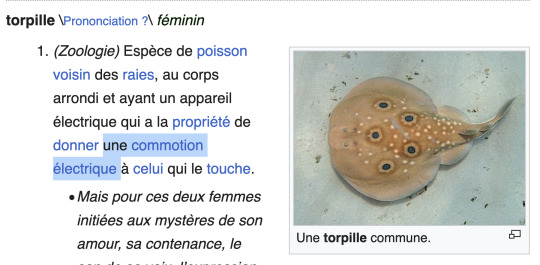

Une commotion électrique? A trembling eel???
Okay so now I NEEDED to read the letter in English. I found an English-language summary published by the Royal Society, but it looks like the only English translation of the full letter was in the appendix of an out-of-print book called “Alessandro Volta and the Electric Battery.”
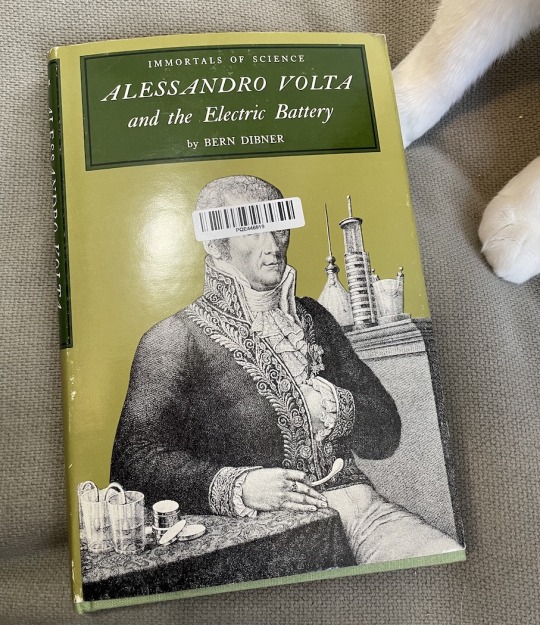
So I bought a used copy. Let's see what Volta has to say about this:

"To this apparatus ... I have constructed it, in its form to the natural electric organ of the torpedo or electric eel, &c, than to the Leyden flask and electric batteries [battery = linked Leyden flasks], I would wish to give the name of artificial electric organ."
Yes! The voltaic pile was explicitly modeled after electric fishes – torpedo rays and electric eels. Fishteriously was 100% correct. Volta never even calls it a "pile," it is always "artificial electric organ." A significant portion of the letter is devoted to electric eels and torpedo rays, in fact.
But also, the rest of the letter is bonkers.

He wrote pages on painful experiments with the artificial electric organ – touching it, poking it into his eyes and ears, making other people touch it, generally just shocking the ever loving hell out of himself over and over. He routinely shocks himself so hard that he has to take breaks. And of course, he licks it.
But that's not the best part:

He says that the artificial electric organ can be turned sideways and submerged in liquid...
"...by which means these cylinders would have a pretty good resemblance to the electric eel ... they might be joined together by pliable metallic wires or screw springs, and then covered with a skin terminated by a head and tail properly formed, &c."
There you have it. One of the most important scientific discoveries of all time, and it includes a crafts project for building an authentic electric eel puppet.
In summary, next time you charge your phone, take a moment to thank the soul of the electric fish inside of it.
2K notes
·
View notes
Text
Man, there is a huge bias in the way that hobby fibercrafters approach and think about textiles—and I say that as a hobby fibercrafter myself! See, weaving has a high barrier to entry relative to knitting, crochet, spinning—even embroidery or sewing, these days, as the sewing machine automated much of the tedium of the craft. All of those crafts require a lot less in terms of startup costs to the hobby crafter than the machinery of a loom does.
But... look, if you want to understand mass produced textiles or textiles in any historical context, you have to understand weaving. If you want to understand how most of the cloth that people wear is made, you have to understand weaving, because weaving is the oldest art for mass producing cloth that can then be turned into garments.
Spinning is also very important, of course. Spinning is how you get the thread that you can turn into cloth any number of ways. Historically speaking, though, the most common way that thread or yarn becomes cloth is inarguably weaving. More to the point, weaving is also a historical center of industry and labor organizing. Ironically enough for the argument about how no one asked a woman, the industrialization of weaving is actually an interesting early case example of men organizing to push women out of a newly profitable position.
Besides that, knitting and crocheting in particular are incredibly modern crafts. Most modern knitting as we would understand the craft is shaped by the inventions of Elizabeth Zimmerman, and even things like the circular knitting needle date back only to the past century. Historically speaking, the great innovation of knitting as a tool for fiber craft is the ability to construct garments for small, odd shapes that can stretch and grip: stockings, gloves, underwear. Even that great innovation, the knit sweater, is an artifact of the 1850s—and the familiar cable knit sweaters of the Aran Isles are even newer than that. Crochet is even younger: the entire craft originated in the 1820s as far as anyone can document.
None of that is any shade on anyone. Like I said, I knit; that's the locus of my personal interest in textiles. I just think that textile history is neat, but if you're going to make big pronouncements about the historical development of textiles, it's important to think about what changed about the technology of textile production in the most common ways of turning raw fiber into cloth—and you cannot stop at the level of understanding how to make thread or yarn, because the properties of the cloth are always going to be an artifact of the construction of the cloth.
That's technology, baby! It's literally weavecraft. But it's not obvious that weaving is missing from the bounds of a person's experience with textile manipulation until and unless they're trying to understand and work with a wide range of fabric types—and when you can quite reasonably go from raw fiber to a finished garment using modern popular craft techniques that don't rely on anything that appears difficult for a medieval craftsman to make, it's easy to forget the role of weaving in the creation of cloth as a finished product.
I suppose the point I am making is: think deeply about what your own areas of expertise are not bringing to your understanding of history. It's easier to miss things you'd think.
225 notes
·
View notes
Text
Oh for fuck's sake, are we having the curse-shaming argument AGAIN??? Every time I think we're done unteaching this nonsense.....
Arright, quick rundown of the points, more or less in order, because I've already had this discussion a hundred times:
One - There is no universal moral or ethical code in witchcraft. Not every witch is a Wiccan or follows Wiccan principles. Not even all Wiccans follow every Wiccan principle, and that includes the Rule of Three / Threefold Law. The Wiccan Rede is ADVICE, not a set of hard and fast rules or divine mandates. You don't get to tell other witches what types of spells they should and should not cast.
Two - If you think the Rule of Three / Threefold Law means, "Whatever you give out comes back to you times three" or if you think it only applies to baneful magic, you don't understand the rule. The original rule, as stated by Robert Graves in "The White Goddess" (you know, the fictional novel that Gardner used as a model for Wicca) states that whatever a witch is dealt, they should deal back three times over. In fact, the passage cites a particular initiation ritual that involves symbolic flagellation, NOT a code of ethics for witchcraft.
It was picked up by later authors as "Whatever You Give" and popularized by media like The Craft and Charmed and authors like Silver Ravenwolf in the 90s when the modern witchcraft movement was having its' millennial boom. (This is a gross oversimplification, but that's when the concept became common enough in pop culture that non-witches were starting to become familiar with the term.)
Three - Karma has absolutely nothing to do with it. Karma is not instant or sentient and the bastardized version of the concept that's been worked into much of modern witchcraft literature more closely resembles the Christian concept of sin and judgment than what karma actually is. Remove the word from your vocabulary when you're talking about magic. The universe does not give one single flying fuck what you do with your spells.
Four - The word you're searching for when you talk about these concepts is CONSEQUENCES. Every action you take, every spell you cast, everything has consequences and everything has a price. This isn't a divine mandate or a cosmic law either. It's a simple fact of life. BUT. It doesn't mean that baneful spells are morally or ethically wrong or that they're going to blow up in someone's face. The only reason a baneful spell might be more likely to rebound is that it's one of the only types of spells that witches actively ward against.
Five - Witches have a right to use magic for persuasion, defense, justice, retribution, binding, prevention, or outright harm if they so choose. If you don't like those types of spells, then don't cast them.
Six - Moral puritanism is a cancer that will destroy us all. Get off your high horse, drop the holier-than-thou bullshit, and remember that being a witch does not make you immune to propaganda.
Thank you for coming to my Toad Talk.
909 notes
·
View notes
Text
Why Writers Should Consider Giving Blind Characters Canes, Guide Animals, or Other Mobility Aids + How To Choose One
(Note: This post is admittedly long and full of information. Make use of the headings to read the parts you are interested in. I have provided many links, which you can read as you go or save for later. I suggest saving this post and taking your time with it. I am also willing to answer any questions for people who have difficulty reading long posts. While I considered breaking this post into parts, I decided to keep all the information in one place for ease of sharing and reference, especially because multiple sections of the post refer to other sections contained within it.)
When I read for blind characters, my most common suggestion for writers is to give their character a cane, guide animal, or utilize another mobility aid. Most stories I beta read feature totally blind characters or people with very little vision, such as only seeing colors. Despite this, it is extremely common for me to suggest giving them a cane or guide animal because they are rarely portrayed using mobility devices. Because this is such a common suggestion, I wanted to create a post about it.
Most of this will be about mobility aids for people who aren’t familiar with them or are still deciding what tools are best for their character. It will also be mostly for modern, realistic, or semi-realistic stories. I will create a separate post for fantasy and science fiction mobility aids, use of magic or magical items, and writing stories set in or inspired by times before formal mobility tools existed. However, I believe this post can benefit anyone who is writing a blind character or anyone who wants to learn more about blindness. Mobility tools are a big part of blind culture, blind communities, diversity of blind experiences, and accessibility.
Learn About Mobility Aids
Here is a comprehensive post by visually impaired fiction writer and blogger @mimzy-writing-online which contains information about canes, O&M, guide animals, etc. If you are not familiar with canes, start there. It contains helpful information for body language, use of canes, and resources for descriptions that any writer will find valuable. The post also has a section on guide animals and sighted guide.
Here is a post I made about crafting fictional guide animals, although I have no experience as a guide animal handler myself. I made sure to research and include links, so it should still be a good starting point. It also has information about differences between service animals and emotional support animals.
Sighted Guide / Human Guide
First, terminology discussion. Sighted guide is a more common term and more examples come up when I search this term. Sighted guide refers to when a person with vision helps guide a blind person. The guide can be abled or also blind themselves. I have guided my friends before and they have guided me. I have often said that, in a way, sighted guide is a misnomer because someone who has less vision or no vision can also guide someone with more vision just as well.
The term human guide makes up for this misnomer by being more accurate. A TikTok by AskABlindPerson or @askablindperson on tumblr, explains this well. Here is a link to the video. The video states the following:
“I’m blind and I definitely prefer to say human guide rather than sighted guide because you don’t inherently need vision to guide and a blind person can do it too. And it doesn’t have to be that the blind person who’s guiding has more vision than the other person either. It can just be that they know the area better than the person they’re guiding, or it could be that they just have better cane skills or independent travel skills than the other person. Because not everybody has equal access to the same exact opportunities for training. So a blind person can also guide, which is why I like to say human guide because it’s more inclusive.”
Not everyone minds which term is used, however. Some people also only use one term because it was taught to them first, rather than because of any particular meaning.
Below are some examples of sighted / human guide and when it is often used.
Here is an article titled How to be a Sighted Guide
Here is another helpful page with information on certain situations such as narrow spaces.
Here is a video by London Vision.
While human guide can be someone’s main mobility aid, it is often used according to the situation.
Situations in which your character might want to use sighted guide include:
-crowds, where a cane might be difficult to use or someone has a companion they would like to avoid being separated from
-while in lines, mostly to provide descriptions of what happens around them or to let them know when to move forward in the line
-ground that is uneven or steep may cause someone to want to use sighted guide rather than a cane, although this will depend on the person. Using a guide and a cane is also possible. A guide animal may go around the obstacle
-when going inside an unfamiliar house or indoor location, usually for locating a specific room
-navigating unfamiliar areas
-public transport
-guide animal handlers may choose to either do traditional sighted / human guide while using the guide animal or give the command for their animal to follow the person without holding onto them
Guides allow the blind person to gain additional information about their surroundings through conversation with the guide. Human guides can also aid in navigation by providing helpful directions or landmarks. Human guides can be used with a white cane or guide animal. They can also be used without any other mobility aid.
People from cultures who place high value on interdependence, especially on family, may wish to use more human guides. People who have anxiety or disorientation may prefer to use human guides or simply travel with someone else for security. Other people who might tend to use more human guides include: people who have moved to an unfamiliar area, people who are losing vision, people who have recently become blind, people with other disabilities or health concerns, or people who prefer the company of others.
In stories, human guides can portray character relationships, establishing trust and respect. Perhaps a character already knows how to guide, showing familiarity with blindness. This mobility tool can display the helpfulness of a stranger or be the start of a meet-cute. Additionally, showing how good or bad a character is at guiding can show compatibility between characters. I also believe that writing guides into a story can allow for detailed visual descriptions or conversation between your characters.
Imagine character A slowly learning to trust character B, culminating in letting that character be a human guide.
Sonar Devices
I wanted to include a section for these because they aren’t often discussed.
Sonar devices are intended as a supplement for use of a cane or guide animal. Unless the sonar and cane are paired together, such as with the WeWalk cane. While they could be used by themselves, this should probably only be with the addition of a guide and in non-crowded, familiar area.
Here is a video review of the Sunu Band by TheBlindLife.
Here is another review comparing two devices: the Sunu Band and the Buzz Clip.
Note how the devices are used, especially with a cane. The cane is used to detect objects from the waist below, whereas the sonar device is used to detect objects above the waist. This includes objects like tree branches.
Sonar devices work by detecting objects in front of the user and giving a tactile alert, such as a vibration. Vibrations increase the closer one gets to the object, giving a continuous vibration when right in front of it. Moving away from the object, such as stepping to the side, will stop the vibration.
This device could allow blind characters to be more active an create interesting opportunities for descriptions.
Why Does My Character Need a Cane, Guide Animal, or Human Guide?
A few reasons include:
1. It will be more relatable for blind audiences if characters move through the world like they do
2. It is more realistic for stories set in our world or worlds meant to be realistic save for a few elements
3. It allows audiences who aren’t blind to understand how blind people move through the world. In the case of sighted guide, it also offers depictions of politely and efficiently offering help to a blind person, which may include not offering help at all.
4. Canes and guide animals give your blind character some visibility, as the cane, and to some extent the guide animal and harness, signify to others that a character is blind or otherwise disabled in some way. As for sighted / human guide, it offers an extra voice for advocacy purposes or the added visibility that someone is being helped.
5. Mobility tools allow blind people to participate more in a world that is rarely accessible for them at a basic level. I almost always find this is true in books as well unless the writer makes a point to include universal design.
6. Mobility aids improve navigation, increase safety, and increase interaction with the world.
Why Would Anyone Need To Know My Character is Blind?
Safety is a big factor.
In this video titled Using A White Cane While Legally Blind by Cayla With a C, Cayla discusses some of the benefits of using a white cane. One of these is that the cane works as an identifier, letting people know the person using it can’t see so other people need to watch out for them. She mentions it is also important for cars and bikers to know cane users can’t see them well or at all, meaning they don’t expect a cane user to move out of the way.
Both Cayla and Molly Burke share in their videos that people are more likely to offer help when they use a cane.
How Do Mobility Aids Help Blind People Navigate?
It depends on what mobility aid is used.
Canes offer more tactile information and direct contact with the environment. Canes allow someone to feel changes in the ground, such as going from carpet to tile. They make it easier to feel steps or broken sidewalk. They allow blind people to be aware of obstacles, such as a chair, rather than simply going around them they way they might with a guide dog. They help blind people locate landmarks they need in order to be oriented in their environment and navigate their way to different places. For example, they may search for a bench, knowing a drinking fountain is across from it.
As for guide animals, because I am not a guide animal handler myself, I wanted to include quotes from a few sources.
The Guide Dog Foundation says the following in a very useful Q&A:
“In short, guide dogs are taught how to find and follow a clear path, maneuver around obstacles, and stop at curbs. They follow their teammate's directions, and they know that they can disobey only in the face of danger.”
And according to International Guide Dog Federation:
“A guide dog is trained to guide its owner in a straight line unless ordered otherwise. The dog will avoid any obstacles en route, above or around you. It will stop at stairs, doors and kerbs. The dog will not decide where to go; it is up to the vision impaired person to instruct the dog on the direction for the dog to go and the dog will safely guide the person as instructed. The vision impaired person will already be familiar with regularly travelled routes and the dog will quickly become familiar with these too.”
And International Association of Assistance Dog Partnership has a page that explains the categories of tasks performed by guide dogs, as well as other types of assistance dogs.
Sighted / human guide can be used with a family member, friend, or helpful stranger. It can be a primary mode of O&M or used when needed, meaning it be used even if someone already has a cane or a guide animal.
Usually, human guide involves contact with the guide. It can also include the guide orienting the person they are leading by describing surroundings such as “there is a bench to the right” or “we’re near the door” or it can involve telling someone where steps are.
How Do I Know What My Character Should Use?
What your character chooses will depend on their lifestyle, level of vision, age, where they live, culture, religion, and their needs as a blind person.
In the post on guide animals, I went over a few reasons someone might choose a guide dog or a guide horse.
Here are some articles about canes vs guide animals. Although the ones I found focus on dogs, I believe many points made about guide animals can be applied to miniature horses as well.
Guide Dogs vs White Canes: The Comprehensive Comparison
The link above includes the following:
“One of the biggest and most obvious differences between a guide dog and white cane is that a guide dog is trained to avoid obstacles along their pathway. A white cane helps locate impediments so that the blind person can decide how best to maneuver around them.”
Another article that may help:
White Cane vs Guide Dog: Why or Why Not?
White Canes and Guide Dogs - What’s Actually the Difference?
Here are some videos:
Guide Dog vs Canes - Pros and Cons by Molly Burke
White Canes vs Guide Dogs by Challenge Solutions
White Canes vs Guide Dogs - Which is Better? 21 Pros and Cons by Unsightly Opinions
Guide Dog vs Cane, Which is better? by Ashley’s Advice
I also wanted to discuss a few more points.
1. Multiple disabilities
People with multiple disabilities may prefer different methods. For example, those who use a stabilizing cane may have different reasons for choosing their mobility aid. I went into that more in this post here.
It would be difficult to cover all other disabilities here, but I will attempt to include some things to consider.
Consider any pain, weakness, or other difficulties your character may have around their hands, wrists, arms. Canes require repetitive use of these areas.
Consider any sensory issues your character has. Sensory issues may come into play with cane vibration and the tactile information given by canes, especially as it differs between surfaces. The video by Challenge Solutions listed above discusses pain caused by vibration and repetitive movement, for someone who already deals with this. It goes into more detail, mentioning that a dog may lessen this difficulty compared to cane use.
Consider phobias or traumas that may make service animals, especially dogs, a bad choice for the character, their loved ones, or community. In contrast, consider how a service animal may help provide comfort to characters with traumas unrelated to animals
I hope that provides a starting point for thinking about how other disabilities may impact someone’s choice when deciding what mobility aid is right for them. I hope this is helpful is choosing a mobility aid for your character.
2. Financial Considerations
Consider financial difficulties. While guide dog schools often provide highly trained dogs, weeks of training, a harness, and some essentials for free, it depends on the school. Some schools may cover the dog’s veterinary care, while others may not. Some may provide one bag of food. Some may cover costs of transportation to the training school, but may not cover the cost of missed work. Challenge Solutions lists several costly areas that go with having a dog, such as grooming or toys.
The amount the training schools cover is so varied that one cannot assume anything about how the blind person keeps up with care of their dog. They may have trained with a school that covers the most costly things, leaving them to buy the occasional treats and toys, while other schools may not cover much after the dogs and handler leave the school, causing financial difficulties that may or may not have been fully anticipated. Financial situations of blind people with guide animals cannot be reliably assumed.
Canes, on the other hand, are a one-time payment per cane, if they aren’t already free. While canes do require replacement tips and while people do go through canes quickly, the cost is not comparable to that of caring for a guide animal.
For writers, it may make sense to have your fictional world contain schools that continue to cover costs over the guide animal’s life. Or perhaps veterinary care is free in that world. Either way, this may be something to consider. The character’s financial situation can show a lot about them and the world in which they live.
3. Additional thoughts about safety and discrimination
Safety has many different connotations in blind communities. Some people consider safety to mean social safety, as alerting others to blindness may explain any behavior that would be considered strange or rude.
Some consider safety to mean physical safety from tripping, falling, running into objects or people, or having them run into you. This is especially important with vehicles.
Still others consider safety to mean being able to navigate and orient oneself, such as when traveling alone.
Some people consider safety to mean interpersonal safety and the fear of being harmed due to being perceived as vulnerable.
Molly Burke mentions this particular subject at around 19:22 to 20:47 in her video here. To paraphrase, she says that having a big dog with her makes her feel safer as a blind person. Molly states that the white cane may increase her vulnerability as it identifies her as a potential target due to her blindness.
I mentioned that it is helpful for people to be identified as blind, such as with a cane and, to a lesser extent, a guide dog. That is still true. This may provide protection by alerting others that they may need to look out for a blind person instead of expecting that person to avoid them or their vehicle.
On the other side, a cane may alert others to vulnerability in a way that is harmful to the blind person. Due to this factor, blind people may feel safer with a guide dog because the presence of a dog may make others hesitate before doing them harm. I am not sure if the same can be said for those with horses, but it is possible horses may still act as a deterrent. In the video by Challenge Solutions, Caitlyn says that while guide dogs are not trained to be guard dogs and should not be aggressive by nature, it can feel safer to travel with a guide dog. Caitlyn says the following: “They are dogs and I would like to think that they would have a protective instinct if a situation arose where that was needed.” She adds, “I think there is more of a protective aspect to guide dog usage than white cane usage. At least I always felt a lot safer with my dog than I do with my cane.”
I also wanted to include thoughts about discrimination.
Some blind people may worry they will experience more discrimination using one mobility aid over another. This may influence their decision. To give brief examples, people with service animals may be turned away from places they are allowed to go. They may need to advocate for themselves more because of this. Another example might be feeling like people judge them or stare at them more when they use a white cane. They may be grabbed or shouted at more often when using a white cane, as described by Challenge Solutions, or they may be ignored or go unnoticed in other cases. In fact, some blind people are only spoken to in public because of guide dogs acting as a conversation starter.
However, feeling invisible in society seems to be a common issue for many disabled people. Some people also talk about being invisible in some areas and uncomfortably visible in other areas. While a blind person’s choice of mobility aid may influence this, the common disabled experience of both invisibility and hyper-visibility might still follow them.
Additionally, myths about blindness, which I wrote about in this post here, may also cause people to accuse cane users of faking if they have residual vision, which can lead to them feeling unsafe or like they cannot use their residual vision without receiving negative attention. This may cause some people to want a service animal, as in the case of a guide dog, some people may assume they are simply walking their dog or training a guide dog. This may be a way some blind people try to avoid being accused of faking blindness. However, blind people with guide animals may also be accused of having a fake service animal or be accused of not really needing their service animal. Additional barriers may include general public ignorance about laws around service animals or differing laws around access per country.
All of the above can put a lot of strain on people who are just trying to get from point A to point B.
Sighted guide may come with some issues as well. Finding someone who is willing to guide and a helpful guide may be challenging unless a blind person is already using a trusted friend or family member. In social situations, other people may misunderstand use of human guide, believing that they should address the guide rather than the blind person. Use of this mobility aid may also come with judgment from others about the blind person being incapable, lazy, or a burden on others. None of these are true, but they can be judgments people make.
Sighted / human guide may be a preferred form of O&M for people who have recently gone blind or are in unfamiliar areas. Additionally, blind people who come from cultures where interdependence is valued may prefer to use a human guide with or without another mobility aid. It is also important to note that the nature of the blind community also celebrates both interdependence and dependence, and these may not always mean the same thing as they do to people who aren’t blind. This is also true when it comes to using mobility tools and techniques.
What Should My Low Vision Character Use?
The majority of blind people have some residual vision, including low vision. Which is part of why most of the blind community doesn’t use canes, along with lack of training. Unfortunately, many people with residual vision are, however subtly, turned away from using canes or other mobility aids. Based on stories from friends, suggestions in this post by @mimzy-writing-online, my own experience, and information online, I will suggest a few reasons this might be the case.
A big reason has to do with believing they have too much vision to require a mobility aid. The idea of not being disabled enough is both an internal an external issue for people with residual vision. This is because people often claim that if a person can see some, they must not require mobility aid. Mobility aids are seen as a last resort, rather than a way to make life easier. This can lead to self-doubt, confusion, or guilt for a blind person. They might feel as if they are ungrateful because they believe other people have it worse. Conversely, some people may have been taught that relying on a mobility tool is shameful, giving up, or reveals a lack of independence. And sadly, some blind people with residual vision may be afraid of rejection or standing out from others.
This leads me into another reason, which is: believing they will experience more discrimination or social exclusion when using a cane. Unfortunately, this can be true. However, it is also true to that not using a cane can cause others to judge someone for things they do or don’t do as a blind person.
Disclosure is an option that works for many. However, blind people cannot always disclose to everyone they interact with, such as to strangers spotting them outside. Disclosure of blindness can also be fraught with accusations of not really being blind, not looking blind, or not being blind enough to count as blind. These accusations sometimes happen when using canes as well. Denial of help, denial of accommodations, and accusations of faking are common.
In some circumstances, the opposite can happen. Instead of being accused of faking, the choice to use a mobility aid might bring about helpfulness from strangers or concern from loved ones. There may be concern that the vision loss has progressed or that something is wrong. After all, suddenly using a mobility tool can inspire alarm in people who aren’t used to them, because the prevailing thought is that mobility tools are only for totally blind people. And the incorrect message behind this is that being totally blind is negative.
Characters choosing to start using a mobility tool could ease themselves and loved ones into it by being open about their plans. They could experiment with cane use, marginally increasing use over time. Or they could simply use a cane as often as they need to, addressing concerns as they are brought up. Portrayal of communication about mobility aids between a blind character and their family could be a lovely addition to a story.
Lastly, blind people are expected to rely on residual vision for as long as possible, in as many situations as possible. Even if it causes pain, disorientation, or anxiety. Even if seeing is exhausting or frustrating. Even if it isn’t safe. However, the other side of this is that many blind people with residual vision enjoy seeing colors or shapes. They may enjoy being able to describe things to friends with less vision.
But their sight may not always be enough to forgo using a mobility tool safely.
It is my opinion that anyone on the blind spectrum or with declining vision can benefit from use of accessibility tools, whether it be learning Braille or training with a cane.
People with low vision can use canes when they feel it is necessary. Examples may include times where they may need extra visibility or extra contact with the ground as they walk. They may choose to use a cane when crossing the street for added safety. Same applies to using stairs. They may bring their cane only to unfamiliar environments or out with them at night. They might feel like using it one day or in one place and not the next. They may have a condition that is not stable from day to day. Overcast weather or dim lighting could make it necessary to pull out a cane. They could simply want to use their cane or decide to leave it at home because they felt like it.
A blind person does not need to a full-time cane-user to be allowed to use one. It doesn’t have to be all or nothing. If they need it, they need it. It is that simple. It will be the same with your low vision character.
Characters may also switch up mobility tools depending on what is best for where they’re going and what is accessible to them. For example, someone may use a human guide for extra safety while in a new city.
Why I Want More Mobility Aids in Media
This is just my opinion, but I would like to see more characters using mobility aids blind people use in real life. This helps to normalize use of these tools for people who are not familiar with blindness. This allows blind people representation that is more true to life. It also adds more detail to stories that wouldn’t otherwise be there.
There is also something off about blind characters who don’t use anything, specifically because most portrayals of blindness involve characters who are totally blind. Why are these characters walking around absolutely everywhere with no familiar way to navigate? Why are tools used by the blind community rejected when it comes to stories about blind characters?
I suspect it is because of a few factors:
1. Not knowing how mobility aids work. Another deterrent could be the difficulties of research and, in live-action media, wanting to avoid training usually sighted actors in use of these mobility tools.
2. Not wanting the blind character to seem too hindered
3. Wanting the mobility aid to be cooler or more interesting if it does exist. This varies by genre and the period in which the piece of media is set.
I find it strange that most stories about blind people do not feature blind characters using tools or techniques blind people use in real life. It sometimes feels as if blindness is a decoration writers add to their story without thinking about how it would impact their character.
My suggestion is to consider the amount of vision your character has, along with their lifestyle, and choose a mobility tool that works for them. I know that some of you are writing characters who can technically move through life without using a mobility aid full time. In these cases, it would be fun to see characters who are transient mobility aid users.
Closing - Not Everything About Blindness is Difficult
I hope this post was informative. I know that some of it may feel contradictory in nature, but that seems to be part of diversity of experience people have with mobility aids. Not everything has to be true for your character or will be true to their experience. Additionally, don’t feel pressure to portray the difficult aspects of mobility aids or being blind in public spaces; it is good to have stories where blind characters are treated well by everyone. There are days when blind people have nothing but lovely interactions with others and when safety is not a concern.
While I mentioned some negative aspects of being blind in this post, there are many positives as well. This can include opportunities to meet new people and have conversations. This can mean getting the chance to use cool gadgets other people don’t get to use. It can also mean being able to experience the world in unique and fun ways, such as noticing little details about the world. It can mean appreciating colors, lights, smells, sounds, or sensations. It can also mean cool navigation tools and techniques.
I will post a part 2 soon. It will include information for writers of science fiction, fantasy, and stories set in historical times. As always, if anyone has anything feel free to share. I will add any responses here as edits to this post.
If you found this post helpful, my pinned post has many more links. I accept asks or messages with questions. I also offer beta reading for blind characters.
-BlindBeta
#blind characters#writing blind characters#ableism#accessibility#white canes#guide animals#sighted guide#mobility aid
1K notes
·
View notes
Note
where did the word alchemy come from?
from the Hanegraaff dictionary:
The West took over the concept of “alchemy” from the Arabic (al-kimiya) and its Latin forms include “alkimia”, “alquimia”, “alchimia” and “alchemia”. The prefix “al-” is simply the definite article in Arabic, but the etymological root of “chimia” is controversial. Its attribution to a mythical hero or prophet cannot be taken seriously. Equally untenable is its application to one of the “sons of God” in Genesis 1 and Joshua 2, named as Chemes, Chimes or Chymes in the apocryphal Book of Enoch, as Zosimos and Olympiodoros report. Even its derivation from the Egyptian word keme (black), denoting the black soil of Egypt and thus a metonym for Egypt itself, whereby alchemy would signify “the Egyptian Art”, has not been widely accepted.
Nowadays it is usually traced back to the Greek work cheo (to pour). Accordingly, chymeia or chemeia would mean the craft of pouring molten metal. In view of what we under- stand by “alchemy” today, it is possible that the Greek word cheein (pouring) became confused with the Egyptian kem (black) in Hellenistic Egypt.
If one looks for the Greek word chemeía in the usage of Hellenistic and Byzantine alchemists, one finds it to be disappointingly rare, for they prefer to speak of a “holy art”. By contrast, the Latin word chymia is frequently encountered in the
medieval West, moreover synonymously with the introduction of the Arabic term, thus “alchemy” (Lat. alchimia). Not until the advent of the modern period is chymia used for the more practical art to distinguish it from the more theoretical alchemey
214 notes
·
View notes
Note
Hey can I get your "history worker slash person who sews "insight on the words seamstress and tailor? Which ones do you use in a modern context? I just despise the contemporary word "sewist" but like. How do you best describe what you do (as a hobby, not professionally)? The gender implications are weird too..
Oh man. You have to realize that I LOVE feminized terms for myself. Adore them. If there were a word for a lady museum professional, I would use it all the time. I am Extremely Woman and I love shoving it in everyone else's face as much as possible. So I do really like "seamstress."
...but I've recently come to the realization that, in my period of greatest interest "seamstress" often just meant "woman who does basic sewing, not cutting and fitting and designing feminine garments." That was a dressmaker. So I use "hobbyist seamstress" and "hobbyist dressmaker" interchangeably. (There is no gendered term for dressmaker because it was often Assumed FemaleTM in the past. To the point where male dressmakers were sometimes called "man-dressmakers" and their hatmaking counterparts, "man-milliners." This sometimes carried connotations of homosexuality- though I've also seen an apparently hetero man, who owned a dressmaking business that his wife ran, called a "ladies' tailor." History is fascinating.)
Sewist is fine with me- I've also heard tailor used as a more masculine term, though some would argue that that has a distinct and specific meaning in the sewing world.
It's kind of a lacuna in sewing lingo, I agree! There really aren't many non-gendered terms for One Who Sews, or at least ones that aren't arguably for specific functions within the craft.
Of course you could always make like Amanda McKittrick Ros, wide-hailed Worst Writer of the 19th Century, and say that you engage in
"...the use of the finest production of steel, whose blunt edge eyed the reely covering with marked greed, and offered its sharp dart to faultless fabrics of flaxen fineness." (Delina Delaney, 1898)
83 notes
·
View notes
Text
If, as they used to say, everyone has a book in them, AI has created a world where tech utopianists dream openly about excising the human part of writing a book — any amount of artistry or craft or even just sheer effort — and replacing it with machine-generated streams of text; as though putting in the labor of writing is a sucker’s game; as though caring whether or not what you’re reading is nonsense is only for elitists. The future is now, and it is filled with trash books that no one bothered to really write and that certainly no one wants to read.
The saddest part about it, though, is that the garbage books don’t actually make that much money either. It’s even possible to lose money generating your low-quality ebook to sell on Kindle for $0.99. The way people make money these days is by teaching students the process of making a garbage ebook. It’s grift and garbage all the way down — and the people who ultimately lose out are the readers and writers who love books.
None of this is happening through any willful malice, per se, on the part of the platforms that now run publishing and book-selling. It’s happening more because the platforms are set up to incentivize everything to cost as little as possible, even if it’s garbage.
[...]
The incentives of the modern book-selling economy for writers are to keep your costs low, low, low and your volume high, high, high, and definitely put your book on Amazon because where else are you going to sell an ebook? The incentive of the modern book-buying economy for readers is to go onto Amazon and lazily click around with a few search terms, and then buy the first book that looks right with the click of a single button. The incentives are, in other words, driving us all straight into a flood of garbage.
69 notes
·
View notes
Text
Hi I am NOT normal about pottery shards and I WILL talk about them
AKA: under the cut is me explaining all the pottery shard designs out in Minecraft 1.20 snapshots as of now (March 23, 2023) in alphabetical order, going over their design and their possible meaning in the lore. Pictures of each shard will be above the text of the listed shard. Now, let's get on with it shall we?

Angler. Starting off simple. A fishing rod with a fish at the end. The ancient society knew how to craft fishing rods and catch fish.

Archer. A drawn bow and arrow. They crafted bows and arrows and knew how to use them. Probably related to skeletons somehow. Maybe the skeletons are them? Maybe the skeletons just stole their technology once they were gone? Unsure.
In real life, bow-and-arrow technology was revolutionary in terms of human evolution. Some archeologists even theorize that bows were the tools that began the end for our cousins, Neanderthals. But in Minecraft... who knows?

Arms Up. A humanoid figure with their arms raised. The arms-up pose means something unknown. Perhaps a gesture of friendship, or peace? What we do know is that, for near certain, the ancient peoples were humanoid in nature, close if not near identical to modern players.

Blade. A sword. Very similar to the standard Minecraft sword model, with a slightly different hilt. Maybe a pixel art limitation, maybe not. The ancient peoples knew how to make swords.

Brewer. A bottle of some description. Seems like a mixed design between a glass bottle and a cauldron. Nevertheless, it has its origins in brewing. They knew how to brew potions. Did they have a different system of brewing to the modern day, or did they have access to the Nether for materials? Currently unknown.

Burn. A flame. They knew how to make fire, or at least knew of its existence. But drawing on the last point, perhaps it's not a fire, but a blaze powder instead. The textures are oddly similar to one another.

Danger. A creeper. Seems like these mobs have been around for a while, and have always been a pain in the backside to watch out for. Wonder if they replied to such a call of danger with "aw man."

Explorer. A map with an X, marking a specific spot. They hid treasures in the ground likely in the same way of IRL pirates - marking a spot on a map for later. Sadly, from modern treasure maps found in shipwrecks, it seems they weren't able to get back to all their spoils in time. Also indicates they knew how to make and use maps.

Friend. An iron golem face. The ancient peoples knew that iron golems existed and that they were protective and friendly towards them. Perhaps, building upon other, older theories, they made the iron golems themselves.

Heart. A standard heart shape. Possibly a visualization of love. Or perhaps they had hearts within them as humans do in the real world, and this is what they looked like.

Heartbreak. A heart broken in two down the vertical center. ...Let's go with the first assumption of the previous shard's imagery. A broken heart is often a symbol of a bad feeling over a lost relationship. The ancient society had intricate relationships between its peoples. They loved and fell out of love, in any and possibly every such meaning of the term.

Howl. A wolf. In the words of a dear friend of mine, "They had doggies!" Or, more likely, began the process of domesticating wolves into the tamable breed we know today. At the very least, they knew of the existence of wolves, regardless of whether the ancient people-wolf relations were good or not.

Miner. A pickaxe. The ancient peoples were able to craft tools like pickaxes to mine for resources. The pickaxe here, much like the sword, is slightly different in design to what we know today.

Mourner. A warden. Now this... this is a very interesting one. I have my own theories that would require a bit more explaining than this format will allow for. (Maybe I will express such thoughts at a later date, if readers wish to hear them...) Let your thoughts be known in the tags!

Plenty. An open chest. This proves that the ancient peoples had the ability to craft chests, and the need for extra storage beyond what could be carried (presumably in their inventories, if they had them).

Prize. A gem. This is an indicator that they were able to mine for resources. Now, some sources may indicate this as a diamond. However, the shape is very distinct from that of any diamonds ever in Minecraft. This may be a completely new - or rather, very old - and different gem than anything players have seen before.

Sheaf. A bundle of wheat. They had means of farming and collecting wheat, and perhaps other crops as well. Agriculture is a part of their culture.

Shelter. A tree. They were able to hide from the elements underneath trees, later emulating this with their own buildings.

Skull. A skull. This could either be the skull of a skeleton mob, from which the skull item drops today, or perhaps the skull of the deceased. They knew of skeletons and death in one form or another.

Snort. A sniffer. This proves that sniffers existed at the same time as this ancient civilization, and that these people were in some form of contact with sniffers.
-~-~-
Remember that anything listed here was important enough to the society of ancient peoples to be immortalized in the art of their pottery. Each one of these has some sort of significance.
-~-~-
Taglist: @darubyprincxx @nightshadeowl @eagle-warri
#i use the word 'golem' only because of its use in-game#i do not fully agree with the term and prefer construct#figured i should state that loll#twelves rambles#minecraft#mineblr#twelves theories#also another disclaimer: any one of these could be wrong#these are educated guesses here#can use for theories IF CREDITED#emphasis on the CREDITED
594 notes
·
View notes
Text
reverse isekai but it’s me at 6:45 pm in a car
-> warnings: spoilers for inazuma archon quest, depictions of modern organized religion(none are specified, none are in great detail, but talks of restrictions within those are mentioned. it’s only one paragraph but still), this is unedited and with zero (0) plot to it :))
-> lowercase intended
taglist: @samarill || @thenyxsky

your world is loud.
from the moment the favored could see it, this was clear. it was loud, filling with screaming machinery that left trails of dust and buildings so tall it made their neck hurt to view.
it was bright, with lights that shone through the darkest of nights, reflecting off glass and the speeding machines and reflecting reflecting reflecting back into eyes to sting. your sun is so harsh, so unpleasant and overbearing, hot instead of warm and burning instead of soothing.
it’s cluttered, wires suspending from towers and running along your roads. glittering signs point out things they can’t read, the sacred script only giving them a headache. at night, they can find no comfort in the stars, something that sends them into a panic the first time they see it. it’s not clouds, it’s not anything worldly blocking their view, it’s that they’re gone, the ones they can see washed out and faded. they wonder how anybody can live like this, and if you blessed them with a night sky of such beauty because yours was so…
they can recognize some of it, the plants and trees and flowers, wild or not, call to them in recognition, but so much is frighteningly new. the style of the clothing, the kinds of jewelry on the people you pass. try as they might, they can’t locate a single vision anywhere, not even on you. they wonder if people hide them, like during the vision hunt decree, but even at home you don’t reach for it, you start fires with odd devices and plants grow slowly, the air and stone unmoving to your desires. you spill drinks. you freeze water using more strange machinery.
it’s so strange, because they can feel your world brim with elemental energy. their vision beams, shining so brightly with all of the potential suspended in your world. no matter how poor their elemental sight, your world glows, the air itself carrying a blue tinge. they try, in a world without visions, to use theirs, and their power springs in an instant to their fingertips. it dances across their hands, enveloping when they barely intended for a small spark, a small flame jumping across the dry grass of unspent energy in your world. they extinguish it quickly, tightening their hand into a fist to stamp it out before they damage something, and something like awe shines in their eyes. there’s so much, their vision so eagerly lapping it up, and you.. don’t use it?
you have machines for everything, devices to harness the wind and waves, boats to travel across water at impossible speeds, strange flying machines that you can hear from the ground, mere specks in the sky, and yet… you have yet to capture them in their most essential forms. you speak of elements, sometimes, but you use different names and there seems to be many, many more. you say that the air holds ‘nitrogen’, that you seal things with foil of ‘aluminum’, and you even say that water itself is composed of ‘hydrogen’ and ‘oxygen’, something that they struggle to understand. how can water be made of something else? how can hydro users bend more than one thing to their will? how can anemo wielders command such a broad spectrum of things? you speak of other elements in the earth, and though some are familiar, such as iron and gold, others’ names hold no meaning. you say potassium is in fruit, that there’s multicolored rocks called bismuth and poisonous liquids named mercury. you say that there’s 118 elements, when all they’ve known is 7.
it takes them a while to come to terms with that one, and even then they settle on it being inherently outside of their understanding. after all, they are in a world crafted by a god.
speaking of..
there are multiple religions in your world?
and it’s not as if they’re different ways or interpretations of the same god, no, it’s entirely different ones. not in the ways of teyvat, where everybody’s aware of all seven and follows the one of their nation, not even that much. they’re wildly different, with different policies and ways of worship, some with multiple gods and others with just one. some are strict, ways of lifestyle chosen and laid out, whilst others are lax. and even within the same religion, it varies from one place of worship to another? somehow? some religions specify clothing, disallowing certain parts of the body to be exposed- which they can understand to an extent. it’s when they learn of religions that police love, ones that write in harsh lines where and when and who somebody can love, that they need to take a step away.
so many parts of your world are confusing. so bright, flashy, new, rumbling in the walls and barreling down the roads with nothing but a scream to warn. lights are everywhere, every sign and post and building vying for your attention. this they could understand, as who wouldn’t wish to be the object of your interest, but the most dizzying fact that they learn during their stay is that you are no different than anybody else. everybody is subject to these sights, everybody is pulled in by a particular shade or cut of cloth, everybody is startled by the bright lights and loud announcements. everybody. you’re lost in the ocean of people so different and yet endlessly identical, nobody’s eyes lingering on you or calling your name specifically. when you step into a crowd, nobody notices you, save for the select, precious few to whom you are known. you have to carve out a place in your world, go out of your way to make sure your name, your face, your interests are kept in somebody’s mind, and even then people dare to forget.
that’s the worst of all. overwhelming lights, sounds, smells: nothing. it makes sense that they’d be out of their depth in a world built for the divine. but to know that you’re not receiving any of the recognition you deserve, to know that nobody thinks highly of your work in teyvat, to know that you were kind enough descend and build yourself a new life amongst the world, and to share your creation across said world, only for nobody to appreciate it. nobody thinks twice. people dare to complain over something you’ve hand-crafted, over something that, even after completion, you revisited with a traveller, doing your best to save one sibling and fix the problems that had cropped up in your wake. you’ve done so much, you’ve cared after it so lovingly, and you boosted the power of some of those you granted a vision to. as somebody who had experienced this love first hand, the favored could not find the words to express their anger at the situation. your world was wrong, it was cruel, and though they found beauty in the most hidden of places, it didn’t change the fact that it didn’t love you.
it only strengthened their desire to take you back to teyvat, where you would be truly loved.
#explanation in the tags#genshin#reverse isekai#isekai#genshin sagau#sagau#genshin impact#self aware genshin#sagau x reader#genshin x reader#cw: religion#cw: religious themes#it’s… meant to be a reverse isekai#but like. they’re ‘shadowing’ you? they’re not physically there because that’s problems and you’re not aware but they’re they’re#there* whoops#spectatoring if you will? yeah that#the title is 100% accurate btw i wrote 83% of this in the car lmao#there are so many things i should be working on but yk what? my blog#do me a favor and just. suspend your disbelief for a moment. ignore how much y/n ‘speaks’ and shut up abt it#it it’s 9:32 when i’m editing and i don’t care enough to fix it tbh#have a post. as a treat <3
899 notes
·
View notes
Note
What are your favorite pieces of media that you think accurately represent magic and spirit work? Movies, books, even music..
This is an interesting question, but one that requires a lot of thought, as I have read and watched an inordinate amount of books and movies. Plus, even really good fiction with pagan themes that I've read/watched is generally inaccurate in most ways, with some realistic aspects of magic woven in here and there. Some of my very favorite media relating to the subject can't really be included, simply because of how inaccurate it is overall, but there are a few that have caught my notice.
I'm sure I'll end up missing ones, which bugs me, but I'll do my best to recount some examples that I can think of:
The Love Witch (2016) is a movie that I think presents a strikingly realistic portrayal of what magic can look like. It manages to show some of the ways one might use magic to great effect, without actually skewing into fantasy at all. Clearly, the magic shown isn't going to line up with every paradigm, and its not exactly a heady or spirit-based story, but I think it's a very real look at how ritual and magic is/can be approached by many folks in the modern day.
The Witch (2015) is, above all else, a great slow-burn horror film and an excellent period-piece. However, it also portrays quite an accurate conception of folkloric beliefs about Witchcraft in the 17th century, which inexorably inform the realities of modern Witchcraft traditions. It does just barely skew into fantasy horror, but the actual folkloric information being presented is quite sound.
A Dark Song (2016) is a film that portrays ceremonial magic realistically in many ways. Ultimately, it is still a supernatural horror film, but the bulk of the magic in the movie is based directly on the Abramelin Operation, which was interesting to see. A lot of the ways that the magic "takes shape" in the film feels real enough to me, too (though it certainly takes it to extremes at points, as horror movies are wont to do).
We Have Always Lived in the Castle by Shirley Jackson is a horror novel I much enjoyed when I read it a coulple years ago, but I also remember that it happens to contain small, but meaningful, instances of sympathetic magic within the story that I appreciated as a practitioner looking in. This one has been made into a movie as well.
Cunning Folk by Adam Nevill is one of the more realistic looks at magic—including the uncanny side of it—that I've come across. It's still definitely a horror story, first and foremost, but there's an oomph to the ritual and magic described therein that a lot of other similar fiction lacks—even when the ritual act being described isn't necessarily accurate in terms of historicality or my personal experience of the Craft.
The White People by Arthur Machen is a Welsh short horror story from the turn of the century, which I think is worth including here. There are elements and aspects of the story that feel surprisingly real in terms of Gloaming initiation and the Gloaming Spirits—though, of course, it takes creative liberties informed by the paranormal beliefs and trends of the time (1890s).
The Craft (1996) is a movie that I'm sure a lot of pagans have of nostalgia for in one way or another, myself included. I struggled with whether this movie should be here or in the Honorable Mention section, but I included it here in the end because a lot of the ways magic and ritual are presented in the film are accurate enough. I also think it did a fairly good job of capturing how it can feel to discover, revel in, and then become overwhelmed by magic. However, since it is a supernatural horror film, a lot of magic shown is portrayed more fantastically than the real thing, and there are aspects of the magic (rituals, entities, etc.) made up entirely for the sake of the story.
As implied above, there are also some pieces that, while largely inaccurate or too far into the realm of fantasy, still manage to succesfully capture some essence of realistic feeling magic in them. I will list those here as Honorable Mentions:
Practical Magic (1998) is another movie that I'm sure a lot of Pagans have nostalgia for in some way or another. I won't claim that it's a genuinely "accurate" representation of magic—and it certainly strays into outright fantasy at times—but there are little things throughout the movie that managed to ring a bell for me, as someone who grew up with magic in my family. I know this was originally a book, but I actually haven't read that as of yet, so I can't speak to it.
Pan's Labyrinth (2006) is a movie is squarely in the fantasy-horror genre to me, but even still, I include it here as an honorable mention because a lot of the lore depicted is drawn from real lore, and the overall ambience it manged to evoke strongly reminds me of some of my own experiences with chthonic journeying.
The Good Witch franchise isn't one I have ever actually watched any part of before, but I include it here because, oddly enough, multiple practitioners have mentioned to me that they think the magic is surprisingly realistic for a Hallmark series. As I understand it, the main character is a sort of local Wise Woman who helps the folk in her little town using things like folk-knowledge, remarkable intuition, and an uncanny ability to seemingly sway people and circumstances. Since I haven't seen it myself, my take on it may be somewhat lacking, (which is why I listed it as an honorable mention), but based on the description, it actually sounds like it may be one of the more realistic interpretations of magic on this list.
I know this is a strange addition, as it's not exactly magic, per se, but much of how Stephen King writes about psychic abilities like clairvoyance and healing throughout his works manages to touch on something all too familiar for me. I think, sometimes, that he may have known someone with the Sight and/or the Touch in his real life, as it comes up a lot in one shape or another in his writing.
As I said, I'm sure there's stuff I'm missing, but this at least a serviceable overview. I encourage others to share any other media that they think deserves a mention, too!
#witchcraft#magic#media#the love witch#the Witch#a dark song#we have always lived in the castle#cunning folk#adam nevill#the white people#the craft#practical magic#pan's labyrinth#the good witch#vistorille#ask
169 notes
·
View notes
Note
I want to learn seidr but idk where to start or what resources are even valid and not tainted by bigotry or transphobia. A lot of posts are very vague, too. So I have no idea what they actually mean. Any thoughts?
Hello! Thank you so much for the ask.
Seiðr is quite the mysterious practice, which is why you must have found difficult to find trustworthy sources, or even one that could clearly define its nature. We currently know very, very little about it. What we do know for sure is that it was a form of pre-Christian magical practice, the uses of which stretched from divination to healing, luck-bringing, controlling weather and making game plentiful (archaeologist Neil Price). It was neither a force of "good" nor one of "evil", as it could also be used to fulfill malicious purposes, such as to cause conflicts or cast curses.
Unlike galdr, which was often practiced by men, seiðr was seen as a rather "feminine" practice. But as always, there have been exceptions to this: after all, mythology has it Óðinn himself, in his eternal search for knowledge, had learned to master seiðr! Though it was considered dishonorable for men to practice it back in Iron Age Scandinavia, it was common enough for a word to describe such men to emerge: seiðmenn. For this reason, neither galdr not seiðr are (or ever have been) confined to specific genders. This, I felt compelled to specify, especially since you've mentionned having stumbled upon many transphobic posts in your research. Galdr and seiðr do not belong to any given gender.
Another difference we could find in modern practice as opposed to historical practice is the means to reach the seiðrkona's staple trance. Archeological finds have informed us that the practice often would have involved trance-inducing intoxicants, which would have enabled the practionner to receive visions and use divination. It's possible for us to recreate such conditions in vastly different ways, namely, using music, chants, repetitive motions and the like.
Now, what's interesting to note is that the Goddess Freyja was also said to be a master of the art. Since she is often thought to be the archetype of a völva, magic practitionners who famously carried a long staff which was crucial to their craft. The term völur actually means "staff carrier", or "wand carrier". This means that to anybody seeking to re-construct this practice, the use of some sort of staff would be near essential.

Though the accounts describing völur and their work are sparse, it's still possible for us to make out a few recurring informations: they were wanderers (and were generally viewed as standing apart from society), which makes them likely to have had some sort of connection with the God Óðinn, and they went from village to village to offer their help and insights. When welcomed into a household, it's very likely they would have been offered to sit at the head of the table, replacing whoever was the head of house in their seat. This means that their presence was considered of the highest respectability. If you're interested in learning more about völur, I suggest checking out the Saga of Erik the Red, which contains the most detailed account of a völva known today.
Another interesting detail to be noted about seiðr is that weaving, whether it was physical or metaphysical, was a central part of the practice. After all, the Norns, who weave the Wyrd, are said to be the greatest of Seiðkonur. Another mythical element to support this theory is that Freyja as a deity seems to share lots of common points with Frigg. In fact, it's very likely the two were worshipped as one deity at some point in time, and depending on the areas. While Freyja is said to be a magician, capable of surviving a pyre thrice, famously, Frigg is more a clairvoyant master of divination, able to foresee the future. And both these different types of witchcraft could very well be considered seiðr practices! Now, Frigg is often depicted weaving using a spindle. That's because her myth has it she is the one who weaves the clouds, and is therefore a talented artist in this domain, which furthers the connection between magic (or at the very least, divination) and the textile arts. It's also interesting to note that the Nornir and Frigg have one major element in common: their ties with fate. While the Nornir weave fate, Frigg knows everything that's to come in the future, though she never speaks a word of it. This particular element of their respective stories greatly emphasizes the imortance of divination and foresight within seiðr practices.
Though I do work with witchcrat, I don't consider myself a practionner of this art per say. That's because oftentimes, the nordic magic I use takes the form of rune-carving, a practice inherent to taufr instead of seiðr. What little information we have on seiðr is unfortunately not enough to determine exactly how it was practiced, apart from the fiew hints here and there. I'm sorry that I can't be of much more help concerning this topic, but I'll link below a few online articles to check out if you're interested in some further reading.
Seidr
Seiðstaffs of the Völur
Encounters with Völur
Manning the High Seat: Seiðr as Self-Making in Contemporary Norse Neopaganisms
The double world: seidr and the problem of Old Norse 'magic'
Norse Magic: Seidr, Shapeshifting, Runes, & More
I will also suggest the book The Norse Sorceress Mind and Materiality in the Viking World and this video, which dive a lot deeper into the topic than I could. The YouTuber Arith Härger, who has multiple times stated his adherence to inclusive heathenry, has posted multiple videos on seiðr in the past, as well.
#magic#heathenry#witchcraft#norse paganism#polytheism#norse polytheism#spirituality#paganism#norse gods#deity work#deities#pagan
123 notes
·
View notes
Text
FFVII Rebirth Demo Impressions
I played the demo several nights ago and loved it! This post is about my thoughts/impressions as I was playing.

(Quick note: My shipping preferences are Cloud/Tifa and Zack/Aerith, so that is going to influence my perspective and what I write about. There will also be spoilers for the OG game and Crisis Core throughout).
One of the first things I noticed as I was playing through was the graphics. The graphics look fantastic. I can tell the game being on the PS5 is making a big difference. The jump in quality from Remake to Rebirth is really noticeable.
It's so weird seeing Cloud act like Zack. Like I KNOW it's Zack and it's creeping me out a;lksdjfdfj because it's just...so not Cloud. They knocked the "this is wrong" vibes out of the park by using Zack's mannerisms and gestures with Cloud's model slapped on top, and it's giving this uncanny valley feeling to everything "Cloud" does. Cody Christian even sounds more like Zack's VA (Caleb Pierce). The attention to detail with all that is excellent. The updated graphics give them a lot to work with in terms of showing the wonkiness with Cloud's memories.
There was also a clever shot in the truck of "Cloud" asking the real Cloud if he's okay, and you see a hint of Cloud's blond hair peeking through the helmet.
I liked the dramatic/heroic version of Sephiroth's theme that played. And when Zack gets hurt by one of the monsters, I think it was Cloud who made sure he's okay, which was a sweet touch. Also, the screen is tinted with green, which is a cool way to show the effects of the Mako poisoning on Cloud.
Another thing I noticed: Cloud's eyes look SUPER green, more so than in Remake. Don't know if it's the upgrade to the PS5 or if they wanted to show the Mako poisoning progressing, but I thought it was a cool detail.
Okay it's like Cloud swapped he and Zack in his memories directly at one point soon after they arrive in Nibelheim. I swear this is 100% what Zack would've said to Cloud about Aerith, but instead it's one of the "security officers" saying it to "Cloud": "So, any friends here you wanna see? Maybe a girlfriend? Speaking of which, I bet you're dying to hear about mine. Am I right?"
Lmao Sephiroth still has groupies, this is giving Crisis Core fanclub vibes and I'm all here for it. I'm glad the game still has those silly moments and that continuity with past games. It makes the tragedy I know will unfold later on that much more poignant.
Speaking of which, it's depressing seeing all the townspeople in Nibelheim knowing they're going to die. Just walking around talking to them, Nibelheim really feels like a lived-in place that Cloud has so many personal connections to.
An NPC asked Cloud if he's seen his mother yet, another one recognized me, and another couple of people noticed me and asked if I'm looking for Tifa. They Know™️
Also, it's really interesting seeing Cloud craft the welcome home he WISHES he had gotten. He wanted to come back to Nibelheim as a hero everyone praised, but the reality was much different. So seeing that contrast is a really good insight into Cloud's psyche and what he wants (praise, recognition, approval, etc.)
Oh found some cats, I'm glad there's another area dedicated to just cats ;aldjf; (complete with photographic evidence):
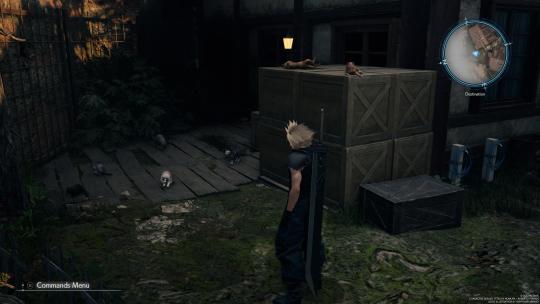
Awwwwww there was a sweet reference to Tifa leading the exercise classes for Nibelheim from Traces of Two Pasts, and she asks Cloud in the modern day if he was able to keep up with the class (she wasn't teaching this particular one, but I love that bit of continuity).
Tifa you can tell is nostalgic for Nibelheim hearing Cloud's recounting of what happened too, the voice acting and dialogue for this part is all really well-done.
The option to see Cloud's mom was really well-done. Cloud never went back to see her in reality, of course, which means his memory glitches out like crazy during this part: he "hears" his mother talking to him about a conversation that happened at an earlier time, like his brain is desperately trying to create something that never happened and is latching onto the nearest fragments it can find. I like how they translated this scene from the OG game, it gave off eerie vibes.
HE DID THE LIL SHRUG AND NOD LIKE HE DOES IN THE OG GAME if you try to enter his mom's house again after the "memory" is over. Also, it's like his mind is trying to protect itself from delving too deeply into a false memory so glitchy (and maybe he feels a deep level of guilt at not actually going to see her as well), and so you can't go back into his house, just like in the OG game.
You can have Cloud go up the water tower too, and he looks towards Tifa's window THE ANGST OF IT ALL a;lskdfj. I love those little moments of Pining™️
Tifa's like wait you went to my place?? Oh Cloud...you were such an awkward weirdo...
"Our reasons, huh? I bet most of them had to do with you." Barret shading Cloud for why he and Tifa didn't hang out more ;alkdjf again I love the humor in these moments.
Awwww Fluffy got mentioned! Nice to hear her brought up again.
"You went into my room?" I'm dead. Tifa sounds so indignant and rightfully so. It's weirdo behavior Cloud ;laskdfj
"You went through my stuff?!" Not off to a great start buddy, but I had him pick that option because I figured he ought to be honest. Tifa and Aerith both call him an asshole if you admit to doing it too, which made me laugh. And naturally my mind is wondering how this will impact the iconic date later on. Did I just piss both Aerith and Tifa off and lose affection points with both girls? Probably lol (and honestly, Cloud deserved it for that stunt).
Tifa's lil moogle plushie on her bed is adorable. I love the touches like that that make the environment feel more lived in.
Awwww I found Tifa's theme to play on the piano hehe. I love that that's the first piano piece you can find in the game. Just one of my favorite FFVII songs because it fits Tifa so perfectly and has this bittersweet sense of longing as well as this beautiful tenderness to it.
Also, I got a kick out of the piano minigame. The first time I wasn't great at it and got a C. I struggled to do both "hands" at the same time. I did it two more times after that, and it starts to sound really nice when you have a streak of a bunch of correct notes in a row. Like Cloud's going to town on the piano with extra flourishes. If you miss notes again though the metronome comes back on lol like "you still need to practice and get the rhythm down."
The second two times I got an A (I'll have to keep practicing to get a star and see what happens), and the gang praised Cloud, which I thought was cool.
Found more Sephiroth groupies and ran into Zangan in the inn. It was really sweet hearing Zangan praise Tifa so highly. Also, "Cloud" saying, "yeah right" when Zangan says "Tifa will go far" is another good clue Cloud isn't himself. Tifa was offended and Aerith was offended on her behalf. I love how Aerith keeps backing Tifa up on stuff, it's really nice to see more of their friendship.
The photographer dude is back and I love him. And he even says the same thing he said to Zack in Crisis Core about how he can't waste his film on Zack because he doesn't know who he is ;alskdfj. What's a guy got to do to get a little respect?
"You look so different" lol yes I do random villager because I'm not me, and then there are some nice creepy foreshadowing moments from her kids. The girl says, "Gonna beat those monsters?" and the boy says, "Gonna be 'em?"
The irony of the mayor saying he'd brag about Sephiroth visiting Nibelheim till the day he dies:
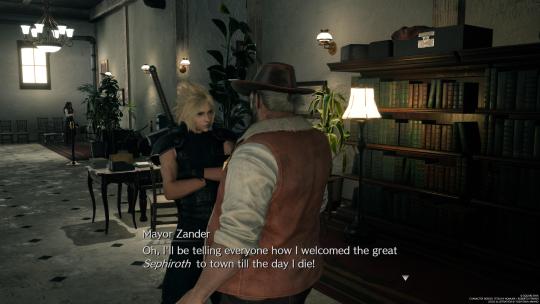
I still really love Brian Lockhart's design. He's like if the 70s met cowboy fashion, and it just works somehow. And this carries over from the OG game, but his concerns about Tifa's safety are well-founded given what happened when she and Cloud were kids and sets up future reveals in the remake trilogy nicely.
Also, Tifa is so small next to Sephiroth. I love her sass in this part of the story, and this time around there's some country twang banjo version of her theme and I love it. Also Sephiroth shaded the camera guy al;sdkfj;dskf but "Cloud" talked him into it and thus the iconic photo came into being. Again those moments of humor will never not be funny. And I loved how Tifa was being such a good guide and giving info about the area as they started to ascend the mountain.
Also, when you finally get to the title screen, it cracked me up how Nomura is listed first, before Hamaguchi. Probably a seniority/respect thing, but Nomura is the creative director and Hamaguchi is the director.
Also, the version of the main theme that plays as you go up Mt. Nibel is awesome, and once again I had to get a screenshot because this area is just so beautiful:
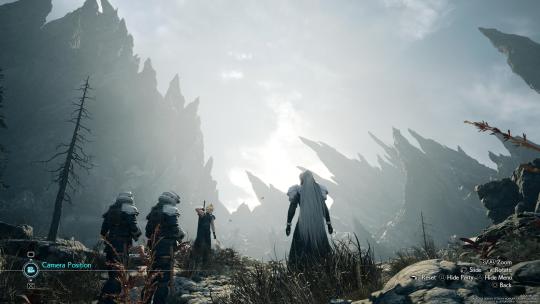
Tifa wanting to travel is a sweet touch, though Sephiroth is practical and points out that he travels on business trips and not for fun. Of course "Cloud" points out that you do learn stuff on these trips. It's a nice contrast between Tifa's naive optimism, Sephiroth's jaded world-weary outlook, and Zack's positivity tempered by experience.
Also, Sephiroth's hair is very swishy. I thought that needed a note as I was playing this. Props to the artists, animators, etc. who rendered it.
I chuckled at Tifa racing up the mountain and teasing "Cloud" and Sephiroth about whether or not they can keep up. Just shows a fun, playful side to her personality and also shows how eager she is to prove herself. And then she dropkicked a monster to protect "Cloud" and then teased him about it alks;jfdsf. She's so much snarkier with Zack than she is with Cloud, and it's an interesting contrast.
The real Cloud of course is in the background, protecting Tifa from danger. Even in his rewritten version of history, the real him is lurking in his subconscious protecting her because she's that important to him. She thanked him so sweetly when he did too.
I made a note about seeing the bridge that collapsed with Cloud and Tifa on it when they were kids, man all the little details like this and the foreshadowing is just A+.
Tifa has Trauma™️ from falling off a bridge before, hmmm, wonder what that's from, and she's still like hey I'm the guide I'll lead us a;ldkfj when "Cloud" offers to go first lol.
Still holds true years later but wooooow Nibelheim sucks at constructing good bridges lol. It was a wholesome moment where "Cloud"/Zack grabbed Cloud and kept him from drowning though, and Sephiroth was able to grab Tifa (which is ironic considering how he tries to kill her not much later, and it's sad because it really shows he was a good guy). Of course the other security officer probably drowned rip, poor guy.
YAY SEPHIROTH'S IN MY PARTY FINALLY
"For your performance review" lol I like Sephiroth's sass and how he teases "Cloud" like this.
I just obliterate everything playing as Sephiroth ;alsdkfj and truly love playing as him. And him slamming his own dad will never not be funny, I mean Hojo just really sucks.
At this point I started focusing more on playing the game since there were more monsters to fight etc., but I still got some nice screenshots and had a few more thoughts.
The Mako spring just looks incredible, so I had to include a photo:
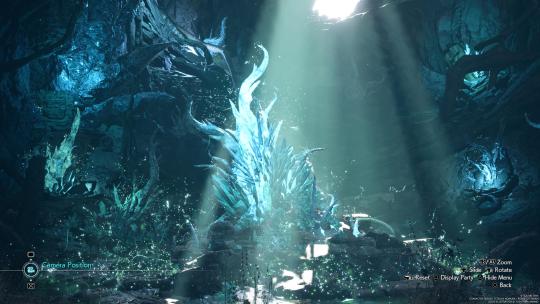
The scenery by the ocean was gorgeous too, I can't wait to go to Costa del Sol:

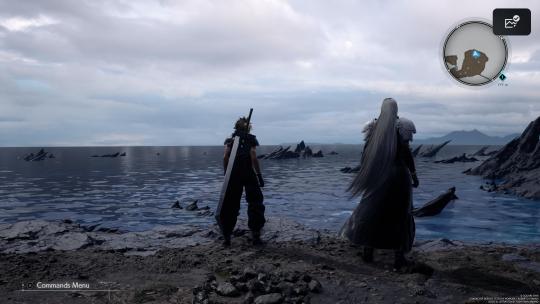
The real Cloud helping Tifa get to safety from the monster and "Cloud"/Zack and Sephiroth being bros is top-tier content. Also Sephiroth looks like a model in pretty much every shot he's in:

Oh the dramatic irony of Tifa not knowing it's Cloud and him refusing to talk and her being sassy and telling him, "You better keep me safe" and then of course he does. The music is creepy now that we're about to enter the reactor lol, of course it is.
"Would it kill this guy to say something" he would die from embarrassment and shame, yes:
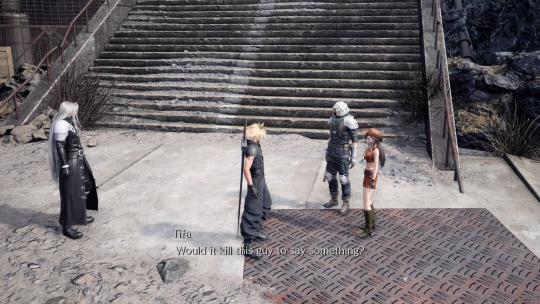
"The company really needs to be more transparent" that's the understatement of the year "Cloud" ;lakfj;asdf
Cool use of JENOVA'S theme. I always enjoy hearing that theme and how otherworldy but also very 90s it sounds.
Zangan's comment here is gold, I love the bee in his bonnet bit:
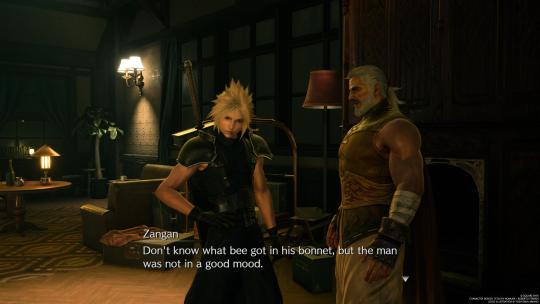
The Shinra basement stuff was genuinely creepy l;kasjdf like I know what happens and I was still freaked out! The atmosphere was just really well done.
"I should go. Mother is waiting." There it is, the iconic meme line a;ldal;skdjf;lsdjf it just kills me, Sephiroth is such a psycho.
Loved seeing Zangan helping people get out of the town and telling "Cloud" to get in there and help, but of course the situation is still incredibly dire by the time "Cloud" gets there.
This shot in front of the water tower was gorgeous and really haunting, especially when the water tower collapsed. Just the symbolism with that, the loss of Cloud and Tifa's special place and how not long after this, he feels like he failed her and failed to keep his promise:

Main Scenario: Check on Mom. Oh Cloud...
And then you see the real Cloud collapsed in front of his house and calling for his mom, this is so depressing:

This is where the more realistic graphics really serve the story well, because it makes this moment that much more of a gut punch, especially when he hears his mother begging him to live. The last few moments before her soul returns to the planet perhaps, trying to save her son from danger one last time.
And now that "Cloud" is hurt, he looks busted up even in the menu. I thought that was a cool detail to include.
It's like Cloud's memories are trying to right themselves because he winds up on the ground like where he was supposed to be. When Sephiroth murdered the man who tried to help him and then went on his creepy murder spree of several other villagers culminating with the mayor, that was all really well done too. Horrifying because there's nothing Cloud can do to stop the senseless murder of people he's known all his life, and it really shows how cold and ruthless Sephiroth has become.
This moment was good too with the memories seeming glitchy again:
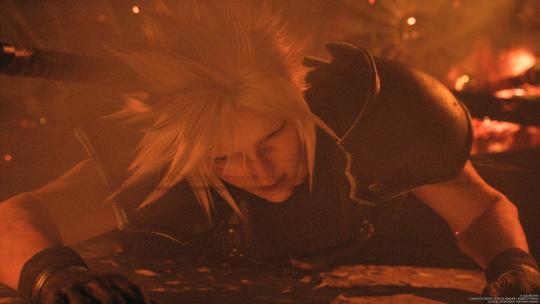
And then of course I must end this on The Iconic Scene™️ a;lsdkfja;kdslf complete with psycho smirk:

Needless to say, I very much enjoyed this demo and am looking forward to the Juno one! And the full game, February 29 can't come fast enough.
#ff7 rebirth#ffvii rebirth#cloud strife#sephiroth#tifa#tifa lockhart#zack fair#ff7#ffvii#final fantasy 7 rebirth#final fantasy vii rebirth#rebirth spoilers#ffvii rebirth spoilers#ff7 rebirth spoilers#final fantasy vii rebirth spoilers#final fantasy 7 rebirth spoilers#ff7r#ff7r spoilers#final fantasy vii#final fantasy 7#nibelheim incident#cloti#cloud x tifa#cloud/tifa#clock strife x tifa lockart#cloud strife/tifa lockhart#phoenix-downer#long post
59 notes
·
View notes
Note
sorry but i think i lost your plot has to be peak literature because it's one of the only thing ive ever read from start to last update in under an hour
Sorry, but I Think I Lost Your Plot pt 14
Pairing: Onesided!Hiccup Horrendous Haddock III x Modern!Fem!Reader
Words: 2,163
You get caught up in some hobbying.
Tags: Time Travel, Reader into Movieverse, crafting, bead making
<Previous - Next>
Your relationship with the older vikings, men and women alike, as their sometimes delivery girl, sometimes shepard -though that was much less of a harrowing job now that the dragons were cool, and you were afforded the privilege of spend a lot less time hiding and running- sometimes portable laundromat and shiphand, afforded you certain knowledge that other people sometimes weren’t privy to, though Berk was an open floor for gossip.
Like how the twins were always looking down because their helmets were too shallow to balance themselves on their heads, which had the consequence of making it seem as if they were always up to something. Which, coincidentally, they were- Their mother complained about them a lot in between mentions of her husband and fawning over Stoick.
You learned how to cook some from Mrs. Ingerman, and you’d taught her a few words from your time period, which was nice.
You’d had to do Snotlout's laundry and clean his room on more than one occasion, even had to pull it out of his basement room more than once, which you were thoroughly disgusted by. You’d learned a lot more about the guy from that experience than you’d ever wanted and had refused to take any of the Jorgensons’ laundry from then onward.
You’d even done things for Hiccup and for the Chief, mostly things he was unaccustomed to doing as he was too busy acting as the leader of the village and things Hiccup missed because he was too busy doing whatever he did out with the riders. You were sure Hiccup’d had no idea just the same as Snotlout.
There were a few things you were certain to never bring up, including but not limited to a hastily drawn but very detailed sketch of your face shoved in a notebook tossed under his bed, not particularly helpful in terms of putting to rest the whole crush thing, or the small pail of screws he was sure to have brought back from the forge without his father’s blessing.
You were in denial a little bit, yeah.
You should probably tell him. About the whole being in his room thing. But you wouldn’t. Definitely not.
It seemed, though, that despite this extra eye into the working world of Berk, you’d still ended up missing a few things.
Berk was… A community. You weren’t sure how you never realized that.
The Great Hall was filled with warm laughter, people patting each other on the back, men and women sharing stories about their kids and, often enough for you to take notice, Hiccup. It looked like raising him was a group effort.
Off in the corner were others at a table by shallow baskets which were shaped like oblong gold pans filled with fine powder and shells, men and women sitting along the side sorting dragon scales and grinding them down with flat stones and clearly chiseled pestels.
Dragons squealed and bobbed around your periphery, tossing and picking up what must’ve been colorful, neutral stones.
Large men and women and children hunched over the tables all over the hall, rearranged so that they were all closer to each other, parallel as they whittled away at things you couldn’t completely see, tables lined with leaves and the occasional plate.
It was well lit.
People filled the halls between tables with joyful conversation, playfully batted at each other and sat back. The whole space was bustling and also relaxing, somehow.
In the background was Ack arguing with some blonde woman, but even that was nice. You could tell he didn’t mean it and neither did she, shooting back just barely inaudible jabs with each other.
You were mindful of the basket in your arms full up with his laundry, just recently cleaned and aired out.
You had stopped in your tracks at the sight, standing just before a short table placed perpendicular to the rest as if the lady sitting there was the guard to some booth or other.
You looked down finally, noticing how she looked at you nearly eye level with a raised brow. She had plenty of wrinkles on her forehead, which told a lot about a life made by concern and stoicism. She also wore a large, very off white apron over a grayish vaguely beige long sleeve short and a long brown skirt, which you only just barely caught sight of as she lifted it up to wipe down something in her hand.
She had a shallow basket in front of her filled with what looked like beads and various strings, needles and small carving knives with wood shavings laid on the cloth-covered table around her.
“Hi,” You said, breaking the wall between the two of you.
“...Hello, dear,” She responded, after a while, settling down her skirt and placing a colorful bead back into her basket. He picked up a needle instead, which you saw was already attached to a long string with beads all down the length.
You wondered where they’d gotten the dye for it. Could dye even be used on glass? Was it glass?
Instead of asking those questions, you shuffled your feet.
You glanced at a white sleeve flopped over the side of the basket, which you held by a bar on the other side and pressed into your hip, “What’s going on?”
“Crafting is going on,” She said, plainly.
You nodded, “I like it.”
It wasn’t an uncommon sight to see Vikings wandering around Berk, trying their hand at leatherworking and carving and other things. Now that they had the time, being assaulted a lot less by Dragons, the Berkians indulged their more artistic inclinations, exercising muscles for skills they’d never been able to before.
“I mean, this is great. What started it?” You asked.
You wanted to join in. It might be nice.
“Oh, you haven’t seen? The pride of Berk, walking around with his little bead like a bird,” She chortled fondly, “Did you see it? I wonder who gave it to him? Lucky girl. He has, dare I say it, started a trend.”
A bird? You quirked your lips up at what was most certainly an exaggeration. You hadn’t seen anything like that. You failed to mention that you’re the one who made it.
You wondered if Hiccup knew about any of this at all. You didn’t.
“How do you know it was a girl?”
You turned. The spoken voice belonged to one of the women you’d see before in the Hall. She came over, done fussing with Ack in the background.
She was also blonde, a brighter, more yellow shade with a few less gray hairs. And she was large, also, with broad shoulders and a strong presence. Her arms were the largest between them.
She wore tight trousers and a large though not long tunic. Her boots were plain leather and looked to be of the pirate variety.
You pondered the idea that they might be related, or at least good friends.
“Look at him!” The first lady put down her needle, resting it in her shallow basket again, a glass bead falling down the string as she did, gesturing with her hand, though there was no Hiccup in sight, “He’s so happy! So proud! The small thing. He’s got too much energy for his little bones to handle.”
You thought he might be offended if he heard her say that.
“Oh, don’t be delusional,” The one with big arms huffed, “And don’t let him hear you say that.”
“But I’m right!”
“You’re wrong! He’s no myth, sweetheart. You can’t go around treating him like one of your little stories,” She shook her head, crossing her arms.
“The Ragnar is real!” She insisted, staring down the Ack lady, meeting her eyes until the other woman rolled her own. You could tell it was a disagreement as old as time itself, but like with the other woman’s squabble with Ack, there was no malice in it, “Beowulf, too.”
They were just putting on a show.
You felt your lips stretch wider. It felt good to be a part of, even as a witness.
“Well, anyways, I’ve been thinking of making it a regular thing. You know, putting it on a schedule. Craft nights…”
You nodded excitedly, “It’s very modern.”
“Do you think so?” She asked, pleased.
“You don’t think we’ll have better things to be doing?”
“Our ancestors used to do it, can’t see why we can’t.”
“Really?” You asked.
“Oh, yes. Read a passage about it once, saw a note or something like in one of the dragon books. Glass beadmaking,” She looked up wistfully, pausing briefly in her rhythmic sewing, “I always wanted to try it… But we had no forge, no beads, no time, then, either. I was just a little girl. But now…!”
She picked something small but shiny out of the basket in her lap, ooh-ing to herself.
You were on the outside, kind of, though not on purpose. Everyone was welcoming enough, though they were much too busy fighting with the dragons to notice much or throw a party or anything. You were never excluded but you always had better things to do, too, so, well.
But this was here, and it seemed convenient.
“Dear, come sit down,” She squealed slyly, voice both quick and dragging, face gleeful, which seemed out of place on her wide, bult frame and stern face.
“Okay,” You said, beaming.
You stuck mostly to the woodworking bead types.
The image of glass beads shattering midair was frightening, though you were sure that none of the dragons around here could reach those speeds. Flying that fast might be dangerous for people too.
Most of your beads were probably going back to Hiccup anyways.
Of course, you had your own handful of small colorful semi-porcelain.
You tried a bunch of colors of all different types, and ended up with a handful of each. It was cool, to the super-so degree, and it was free. It seemed good will did a lot, and community bonding exercises were meant to be just that and nothing else. There was a line of Vikings, adults and children alike, ready to do their own part and bring things in anyhow.
Many Vikings used ground up dragonhide to dye and waterproof beads and to mix in with melted glass in order to give it a pretty stain.
It was interesting, especially now that many Vikings were using Dragons in place of a kiln, and how they’d set up small buildings with bricks and some coal and used those too.
It was disastrous, at some moments. There were many burns, mostly small, that people went up to Gothi for, saying their goodbyes in bummed tones.
Gothi must have had enough of it because she came down eventually to manage the glassmakers and smack the unfortunate.
It was… nice.
The afternoon light was surprisingly nice on your face. It felt a lot nicer and your chest felt lighter, the world awash with things bright and endearing.
You looked forward with a winning smile at Hiccup.
“You liked the one I gave you, right?” You held out a handful of blue glass and wood beads to Hiccup, “They’re doing craft days in the Hall. I made some.”
You had a bunch of others in pouches around your belt.
You didn’t have anywhere to put them besides. You had no dragon to ride, so in time you might favor the glass ones. You had trouble with a few of them. The dragonhide did a great deal to make the glass more sticky when it heated up.
“You’re going to see a lot more people around with beads on.”
There were not enough leaves and pouches for all your sorted beads so they were sort of mixed, but you got a hold of a good few before it was time to clean up and you fled before anyone could notice. The hall would still be active for a while.
“You started a trend, I think,” You said, matter-of-factly.
It was impressive. Trends usually fell to the Chief, who recently had been trying to approach you though he always got carried away by tasks before he could.
Hiccup had a sort of goofy smile on his face which consisted of a slightly upturned lip and the framing of his two largest front teeth which dropped as, as it looked like, he snapped back into himself, “What?”
“Yeah,” You said after you finished unloading the rest of his pouches into his arms and turned to walk away.
You looked around as you fled, making sure no one was watching.
He looked down like he wasn’t sure what to do with all of them, and also a little bit put off.
You wondered if you overdid it.
A small weight shifted by your ankle as you walked, the coins you’d slipped into a side pocket in your boot. You were going to ask around for some seeds.
#thank you#hope you enjoy#httyd#how to train your dragon#hiccup x reader#httyd x reader#fem reader#hiccup horrendous haddock III#hiccup haddock#x reader
61 notes
·
View notes